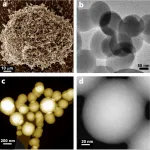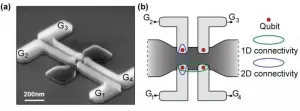(Press-News.org) New research produced jointly by The Swire Institute of Marine Science (SWIMS), Faculty of Science, The University of Hong Kong (HKU), and The Nature Conservancy (TNC), published recently in the scientific journal Restoration Ecology, shows the enormous potential of restoring lost oyster reefs, bringing significant environmental benefits.
Benefits of oyster reefs
Hong Kong was once home to thriving shellfish reefs, but due to a combination of factors including over-exploitation, coastal reclamation and pollution, shellfish populations have declined drastically. Restoring oyster reefs along urbanized coastlines can mitigate some of the environmental problems typical of coastal development, such as damage from storm surge and loss of biodiversity.
"Globally, we have lost 85% of shellfish reefs, making it the most endangered marine habitat on earth," said Marine Thomas, Conservation Project Manager, for TNC in Hong Kong. "Most people associate oysters with food, but less well-known is that oysters create reef habitats that support coastal marine life. Only by restoring these lost habitats can we start to bring back some of the associated environmental benefits."
A primary benefit that healthy oyster reefs contribute to coastal environments is their role as natural water purifiers: This new study found that, just 7 m2 of Hong Kong oyster reef can filter up to one Olympic swimming pool of water each day; a single Hong Kong oyster (Crassostrea hongkongensis) can filter up to 30 liters of water per hour at summer temperatures, among the highest filtration rates recorded of any oyster species.
Even more importantly, oyster reefs provide habitat and nursery grounds for many native species that are otherwise lost from our shores. Another recent SWIMS study conducted in partnership with TNC found that these reefs house six times more species than bare muddy shores. The research found over 80 species on intertidal muddy shores in Deep Bay, 95% of which were found in oyster reefs, and almost 60% of which were exclusively found in those reefs.
Oyster reefs restoration
"A previous SWIMS study found that Hong Kong is home to approximately 6,000 marine species and 26% of all marine species in China. This new research adds to that list, as we've identified a small crab previously not seen in Hong Kong. This shows us just how under-studied these ecosystems are," said Dr Bayden D Russell, an Associate Director of SWIMS and Associate Professor in the Research Division for Ecology and Biodiversity, HKU.
Another benefit of restored reefs is increased production of commercially and recreationally valuable fish and crabs.
Further, demonstration of successful restoration in one of Asia's coastal mega-cities can also act as model, providing evidence for the environmental and societal benefits of ecological restoration within the region.
In some parts of the world, oyster reef restoration has only been successful by transplanting juvenile oysters cultivated in hatcheries into the wild. However, this new research demonstrates that natural recruitment of oysters in Hong Kong is high, meaning that restoration could potentially be achieved without the need for hatchery-reared oysters.
"We were excited to find high natural recruitment levels which suggests that oyster reef restoration is possible without hatchery intervention," said Dr Russell. "We think that this recruitment is because traditional oyster farming in the Pearl River Delta has maintained populations of native oysters in the system in spite of the loss of oyster reefs and these farms could potentially act as a source of larvae."
In assessing 10 sites where small remnant shellfish habitats are found in Hong Kong, the study also found that large oysters (beyond 1 year old) are very hard to find in the wild, due to on-going harvesting pressures.
"While we are excited by the biological feasibility of restoration, unfortunately the human aspect remains our biggest challenge to bring these habitats back at scale. Shellfish habitats are still severely under protected in Hong Kong, with very little public awareness of their ecological value. Wild harvesting is a huge problem - as soon as oysters or mussels are big enough to eat, someone will harvest them. We are working with Government on gaining more protection and recognition for these important ecosystems and hope to include them in the next Hong Kong Biodiversity Strategy and Action Plan (BSAP)," said Ms Thomas.
INFORMATION:
Paper reference:
Lau SCY, Thomas M, Hancock B, Russell BD (2020) Restoration potential of Asian oysters on heavily developed coastlines. Restoration Ecology, 28, 1643-1653.
https://doi.org/10.1111/rec.13267
Image download:
https://www.scifac.hku.hk/press
Angiosarcomas are clinically aggressive tumours that are more prevalent in Asian populations
Study led by Singapore clinician-scientists has found a way to classify angiosarcomas into three subtypes, allowing for more targeted treatment, better outcomes for patients and the development of new therapies
Findings were published in The Journal of Clinical Investigation in October this year
Singapore, 29 December 2020 - A new study led by clinician-scientists from the National Cancer Centre Singapore (NCCS), with collaborators from research institutions worldwide, has found that angiosarcomas have unique genomic and immune profiles which allow them ...
A fast, green and one-step method for producing porous carbon spheres, which are a vital component for carbon capture technology and for new ways of storing renewable energy, has been developed by Swansea University researchers.
The method produces spheres that have good capacity for carbon capture, and it works effectively at a large scale.
Carbon spheres range in size from nanometers to micrometers. Over the past decade they have begun to play an important role in areas such as energy storage and conversion, catalysis, gas adsorption and storage, drug and enzyme delivery, and water treatment.
They are also at the heart of carbon capture technology, ...
Researchers at the University of Turku have discovered what type of neural mechanisms are the basis for emotional responses to music. Altogether 102 research subjects listened to music that evokes emotions while their brain function was scanned with functional magnetic resonance imaging (fMRI). The study was carried out in the national PET Centre.
The researchers used a machine learning algorithm to map which brain regions are activated when the different music-induced emotions are separated from each other.
- Based on the activation of the auditory and motor cortex, we were able to accurately predict whether the research subject was listening ...
In a series of commissions awarded by the Federal Joint Committee (G-BA) to the Institute for Quality and Efficiency in Health Care (IQWiG), the question is whether for certain surgical procedures, a correlation can be shown between the volume of services provided per hospital and the quality of treatment results. IQWiG's rapid report on heart transplantations is now available.
According to the findings, a positive correlation can be inferred between the volume of services and the quality of treatment results for heart transplantations in adults: In hospitals with larger case volumes, fewer of the transplanted patients die, both in timely association with the intervention ...
Quantum computer: One of the obstacles for progress in the quest for a working quantum computer has been that the working devices that go into a quantum computer and perform the actual calculations, the qubits, have hitherto been made by universities and in small numbers. But in recent years, a pan-European collaboration, in partnership with French microelectronics leader CEA-Leti, has been exploring everyday transistors--that are present in billions in all our mobile phones--for their use as qubits. The French company Leti makes giant ...
Imaging techniques enable a detailed look inside an organism. But interpreting the data is time-consuming and requires a great deal of experience. Artificial neural networks open up new possibilities: They require just seconds to interpret whole-body scans of mice and to segment and depict the organs in colors, instead of in various shades of gray. This facilitates the analysis considerably.
How big is the liver? Does it change if medication is taken? Is the kidney inflamed? Is there a tumor in the brain and did metastases already develop? ...
December 28, 2020 - Platelet-rich plasma (PRP) treatment, which involves injecting a small amount of a patient's own blood to release various growth factors from platelets, continues to increase in popularity. The American Society of Plastic Surgeons has tracked the procedure since 2015 and reports a 25 percent increase in cosmetic PRP use in the last four years.
That increase in popularity could in part trace back to celebrities extolling the procedure's cosmetic benefits. Yet with so much information coming from so many different sources about the treatment's ...
Cells, the basic unit of life, are surrounded by a limiting membrane called the plasma membrane. Inside cells, there are various membrane-bounded organelles, each of which has various and distinctive functions. How these organelles, which individually boast different functions, have been developed during evolution remains unknown. This phenomenon has fascinated many researchers.
In the study published in Nature Communications, the evolutionary relationship between two different organelles in liverwort cells has been revealed: the cell plate, which divides ...
Two new studies from the University of Rochester Medical Center (URMC) have uncovered an association between vaping and mental fog. Both adults and kids who vape were more likely to report difficulty concentrating, remembering, or making decisions than their non-vaping, non-smoking peers. It also appeared that kids were more likely to experience mental fog if they started vaping before the age of 14.
While other studies have found an association between vaping and mental impairment in animals, the URMC team is the first ...
Researchers from Yokohama National University in Japan have developed a prototype microprocessor using superconductor devices that are about 80 times more energy efficient than the state-of-the-art semiconductor devices found in the microprocessors of today's high-performance computing systems.
As today's technologies become more and more integrated in our daily lives, the need for more computational power is ever increasing. Because of this increase, the energy use of that increasing computational power is growing immensely. For example, so much energy is used by modern day data centers that some are built near rivers so that the flowing water ...




